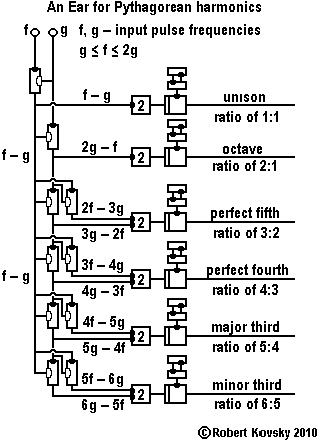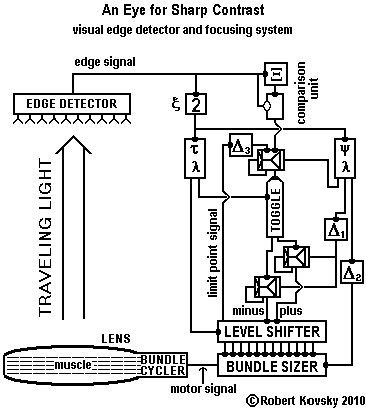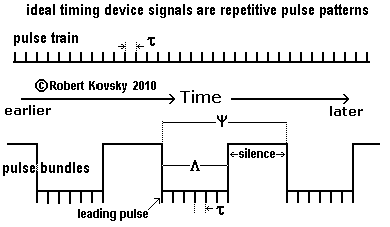Brain Models Built From Timing Devices:
Opening Page
- "Timing Devices" is proposed new technology that:
-
• shows new principles in operation — principles, I suggest, that also operate in biological brains;
• has a practical approach in ( ... ) "Timing Devices: a Kit of Parts";
• is being developed through specific projects described in detail on separate pages:
( ... ) "An Ear for Pythagorean Harmonics" (2010) – a simple, self-contained model of one aspect of auditory processing;
( ... ) "An Eye for Sharp Contrast" (2011) – a more complex model of sensory-motor processing that is built from the Kit of Parts and that launches a program of development;
• has a separate formal technical statement in ( ... ) Fundamentals of Timing Devices; and
• originated from another new technology, ( ... ) Quad Nets (2006).
For background, please see ( ... ) "Author, History and Related Publications."
Opening Page Contents
( ... ) 1. Timing Devices, a New Technology
( ... ) 2. A "Kit of Parts" Similar to Electronic Components
( ... ) 3. Timing Device Signals and Their Meanings
( ... ) 4. Purpose of the Timing Devices System

|
1. Timing Devices, a New Technology.
Radios, steam turbines and computers are examples of existing technologies. Each technology is based on mathematical concepts that are embodied in operating devices. Mathematical concepts and devices for the examples include Fourier analysis, the Carnot Ideal Heat Engine and the Universal Turing Machine respectively.
Such technologies go through a course of development that begins with very simple original or primal devices. The primal devices are modified in various ways, resulting in classes of devices. Different devices are interconnected to build systems that perform specific tasks. Challenges to perform additional tasks lead to more devices and more development of the mathematical concepts.
( ... ) "An Ear for Pythagorean Harmonics" shows that the timing devices system has a mathematical basis and potential for development like those of previous technologies. The contents of the timing devices system – its devices, signals and operations – are new and conceptually different.
|
( ... ) top of page
|
2. A "Kit of Parts" Similar to Electronic Components
The timing devices system resembles the system of "standard electronic components" used in circuits that process radio broadcast signals and computer signals. Both systems have the following features:
- Useful signals are based on exact forms that are mathematical in nature. The simplest signal in timing devices, an ideal pulse train, resembles a sine wave, the simplest signal in standard electronic circuits.
- Proposed systems are built from a "kit of parts" where the parts are specific physical devices. In standard electronic circuits, parts in the kit include resistors, capacitors, diodes, transistors and photo-sensors. The timing devices kit of parts includes the primal timing device, gate devices, difference devices, sensory-modulated devices and memory devices.
- Devices from the kit of parts are assembled to make a "module" that performs specific functions and that can be incorporated into larger assemblies. In electronic circuits, modules include signal generators, modulators/demodulators, logic gates, counters and power amplifiers. As shown in ( ... ) "An Eye for Sharp Contrast," comparable modules for the timing devices system include signal generators τ and ψ, Edge Detector, Toggle, Level Shifter and Bundle Sizer respectively. The Bundle Cycler is more like an automobile distributor, sending copies of the "motor signal" to muscle fibers in waves. ( ... ) "Timing Devices: a Kit of Parts," defines the operations of all the basic devices used to build the Eye and its modules.
|

|
( ... ) top of page
3. Timing Device Signals and Their Meanings
Timing device constructions begin with signals that have exact, perfectly defined forms called ideal. The class of ideal constructions includes Euclid's geometry, the Ideal Gas Law (pV=nRT) and musical scales.
|
A timing device signal is a sequence of pulses, where each pulse exists for a specific instant. As a practical matter, an "instant" is an interval of time much smaller than all other time intervals in the system.
All timing device pulses are the "same." Each pulse is a distinct package of action. In modeling biological organisms, a pulse has contributory power in causing sensations or muscular movements.
|

|
The Figure above shows a "random" sequence of pulses and distinct times they appear on a particular line.
Pulses appear on lines or "projections" between timing devices and they travel instantaneously between timing devices. That is, during its instantaneous existence, a pulse is produced or discharged by a timing device, travels through a projection and arrives at a device or multiple devices. (Electrical signals are almost but not quite instantaneous. Nerve signals are less speedy. Timing device models can be modified to accommodate travel times.)
In contrast to electronic circuitry, where frequency is the primary unit, the primary unit in timing devices is the period. A period is defined as the interval of time between a pulse and the preceding pulse. The frequency f, if it can be defined, is the inverse of the period or f=(1/τ) but such definition requires an orderly or uniform sequence of periods. If the uniform period between pulses is 1/4 of a second, the frequency of pulses is 4 per second.
In the timing devices system, periods in a signal are always exact and exactly known, even when random. A signal may not have a frequency or have only an approximate, average or changing frequency.

|
The adjacent Figure shows two ideal timing device signals: a pulse train and pulse bundles. Ideal signals are perfectly repetitive.
An ideal pulse train is a repetitive sequence of pulses with a fixed time period, τ, between any two pulses. An ideal pulse train has a perfectly defined frequency.
Ideal pulse bundles are repetitive sequences specified by three fixed time periods, τ, Λ and ψ. Within an ideal bundle, the signal period between any two pulses is τ. Each bundle has a durational period, Λ, between the first or leading pulse and the last pulse in the bundle. The durational period and a period of silence between bundles make up the largest period, the organizational period, ψ.
|
A principle of design (at least up to this time) is that sensations are based in pulse trains and muscular movements are stimulated by pulse bundles.
That is, pulse trains are the form of initial signals that generate sensations in both the model of auditory processing (Ear for Pythagorean Harmonics) and the model of visual processing (Eye for Sharp Contrast). Pulse bundles may be used for later sensory processing (see materials involving Figure 36 in the technical paper ( ... ) "An Ear for Pythagorean Harmonics"); but the general principle is that a continuously variable pulse period in a pulse train measures a variable sensation.
In proposed models, pulse bundles drive muscle-like movements. A muscle is made up of many muscle fibers that run in a nearly-identical way between two points of attachment located on other body parts, e.g., attachments on bones. A muscle-like movement is caused by organized twitches of muscle fibers. During a twitch, a muscle fiber pulls the two points of attachment together with a force. Each twitch of an individual muscle fiber is driven by a pulse bundle targeted to that muscle fiber. The fiber relaxes between twitches. A fixed or steady force between the two points of attachment can be maintained by cycles and waves of pulse bundles directed at a muscle made up of muscle fibers. Then, varying pulse patterns can cause muscle-like movements. A simple example is "jaws for cracking nuts," shown on the ( ... ) Kit of Parts page.
( ... ) top of page
4. Purpose of the Timing Devices System
The ultimate purpose of the timing devices system is to establish engineering foundations for my ( ... ) Testimony of Freedom. I hold that freedom is an operating principle that is embodied in biological brains and that is also embodied in ( ... ) Quad Net devices in the form of Shimmering Sensitivity. Timing devices are a reduced form of Quad Net devices that have turned into a developmental path leading towards the ultimate purpose.
Multiple lifetimes would be required to achieve the ultimate purpose. Notwithstanding this fact, the ultimate purpose has been fruitful in guiding development of the timing devices system. Principles embodied in timing device projects suggest a possible path of development that starts from simple systems.
Principles are developed through specific projects – an Ear and an Eye. I suggest that the same principles are embodied in muscular movements of animals. The principles also identify and organize my own personal experience, especially experience of my own muscular movements. Such principles include the use of ideal forms and repetitive "tiling," a principle of action, the principle of resemblances and principles of selection, switching and combination. A standard gym or exercise club that has free weights is an excellent place to experiment with these principles.
The principles are also embodied in device designs. As a first, simple line of investigation, the principles organize activity of following that has both physical and psychological aspects. E.g., following a tune and following a moving object with one's eyes.
A chief design goal of timing device and Quad Net projects is the construction of systems that generate multiple possible activity patterns and select from among them, with actual muscular activity expressing the selection. That is, muscular activity occurs in a context where multiple forms are possible and operational processes result in the expression of one form and the extinguishment of the other forms. The goal is being pursued through multiple branched device structures (an Ear for Pythagorean Harmonics), variable signals (an Eye for Sharp Edges) and multiple co-existing germinal activity patterns in Quad Net device parts (principle of Shimmering Sensitivity).
Sometimes, a selected activity pattern is maintained for an extended time and the organism performs repeated muscle-like movements, like a bee heading towards the hive. Sometimes patterns are selected afresh during each cycle, like a pigeon twitching into new positions. Patterns can be switched so that one is replaced by another, like alternately speaking and listening. Capacities for switching can take the form of a graded sequence of activity patterns, e.g., gaits of a horse. As shown in both knitting and classical music, some kinds of activity patterns can be combined in multiple ways, leading to proliferation of forms and further development.
Selecting, switching and combining are high level capacities. At a lower level, an organism can start, stop, repeat, sustain, speed up and slow down activity patterns. Some activity patterns can be performed in a sequence of distinct acts (which I call deeds), such as playing notes on a violin, speaking words or stroking the keys of a computer keyboard. Deeds can be organized into structures such as tunes, sentences and programs.
Extending such constructions to personal experience, I suggest that a person has experience of repetitions, selections and switches of muscular movements. E.g., climbing a staircase, folding laundry or playing a videogame. The person experiences herself or himself as controlling some repetitions, selections and switches, as well as controlling the starting and stopping of actions. Separate streams of actions can be maintained – e.g., cooking dinner and talking to a friend. The person experiences himself or herself as possessing, at least in part, capacities to start, stop, maintain, repeat, select, switch and/or combine muscular movements.
A person exercises freedom, as I use the word, through capacities to start, stop, maintain, repeat, select, switch and combine muscular movements. As shown by Piaget's child developmental psychology, muscular movements are the foundation of verbal and symbolic actions. I suggest that similar freedom occurs during other meaningful activities of a person engaged in pursuing goals and projects of construction. The ultimate purpose of timing devices and Quad Nets is to model capacities of a person to control his or her own actions in pursuit of goals. The designs and constructions shown on these pages lead toward models of persons engaging in sports, market purchases and courtroom trials, exemplary activities of persons exercising freedom.
( ... ) top of page
Site Links
Brain Models Built From Timing Devices
( ... ) Opening Page
( ... ) A Kit of Parts
( ... ) An Eye for Sharp Contrast
( ... ) Eyes That Look at Objects
( ... ) An Ear for Pythagorean Harmonics
( ... ) A Procrustean Group of Harmonies
( ... ) Fundamentals of Timing Devices
( ... ) Author & History
Related Materials
( ... ) Quad Nets
( ... ) Testimony of Freedom (current long-range project)
( ... ) Embodiment of Freedom (archives of development)
Your comments and suggestions are welcome.
Please write to the adjacent email address (shown in an image to minimize spam).
|

|
2/27/11
Copyright © 2011 Robert Kovsky




